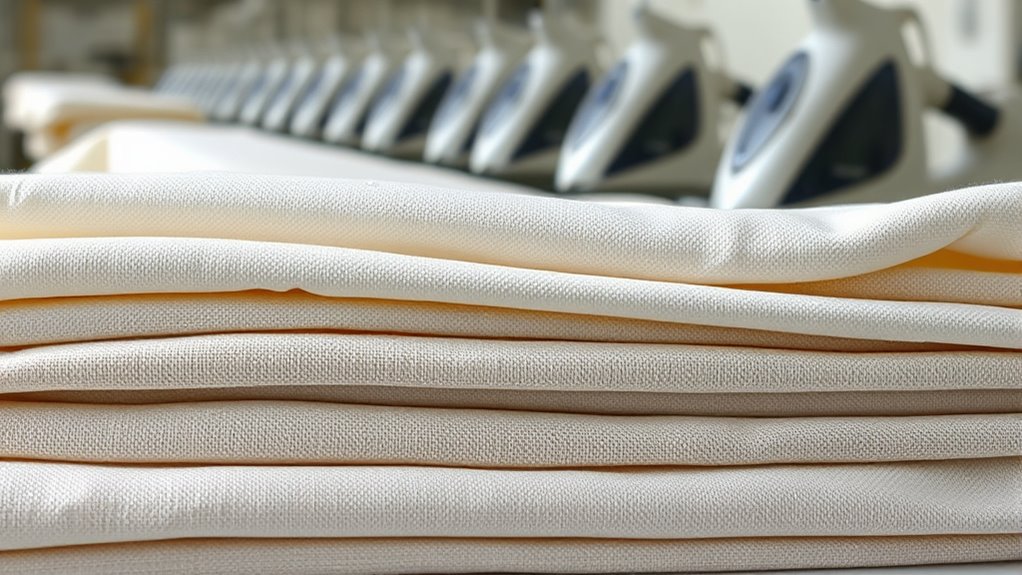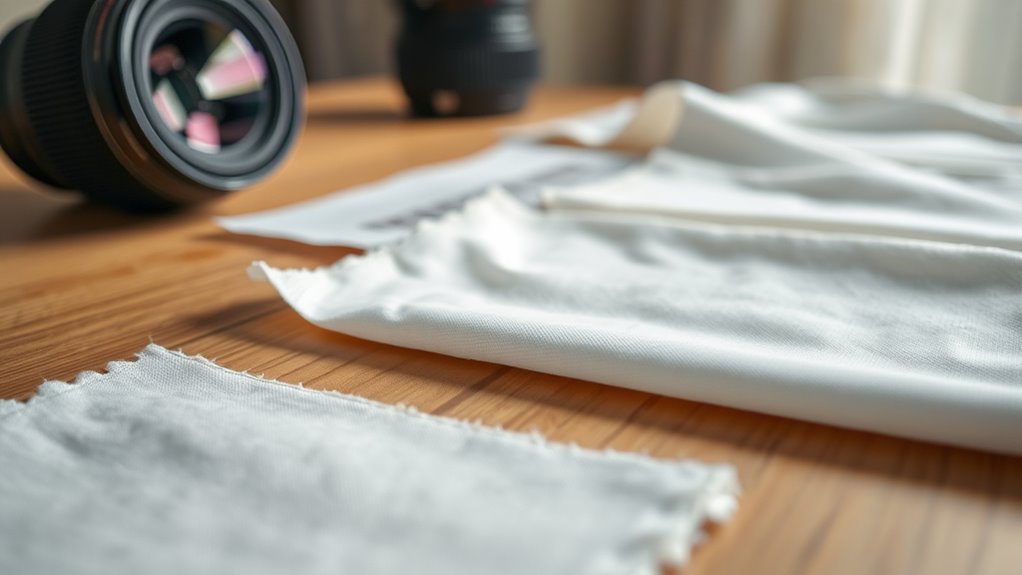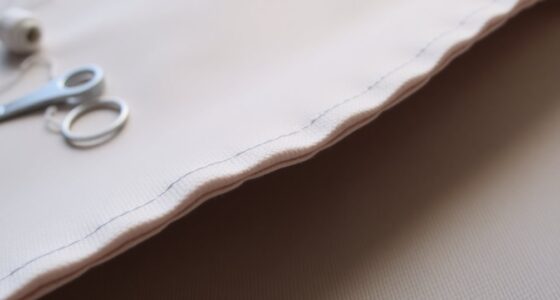Preshrinking fabrics helps reduce future shrinkage and keeps your clothes fitting well over time. While natural fibers like cotton and wool are more prone to shrinking, proper pre-washing, gentle steam, and air-drying can make a big difference. Don’t rely on magic solutions—understanding fabric care and textile treatments is key. If you want practical tips and bust some common myths, keep going to learn how effective preshrinking really is and the best techniques to use.
Key Takeaways
- Preshrinking reduces natural fiber shrinkage but doesn’t make fabrics completely shrink-proof.
- Proper preshrinking involves gentle washing and low-heat drying to stabilize fabric size.
- Myth: Preshrinking can eliminate all future shrinkage; it mostly minimizes initial dimensional changes.
- Natural fibers like cotton and wool benefit most from preshrinking, while synthetics are less affected.
- Understanding textile sizing and care labels ensures effective preshrinking and maintains garment quality.

Preshrinking fabrics is a smart step you can take to prevent your clothes from shrinking after washing. When you understand how fabric care influences the longevity of your garments, you can save time, money, and frustration. Many people assume that simply washing clothes at a certain temperature will prevent shrinking, but the truth is that textile sizing and fabric treatment play significant roles in how your clothes respond to washing and drying. Preshrinking isn’t about magically making your clothes resistant to change; it’s about preparing the fabric so it maintains its shape and size over time.
Preshrinking fabrics helps maintain your clothes’ shape and size over time.
Fabric care begins with understanding the specific needs of different textiles. Natural fibers like cotton, wool, and linen are more susceptible to shrinking, especially if exposed to heat or agitation. Synthetic fibers such as polyester or nylon are generally more stable but can still experience dimensional changes if not cared for properly. Before washing, check the care label for recommendations. If you’re concerned about shrinkage, considering a preshrinking process can be beneficial, especially for garments made from natural fibers. This often involves a controlled pre-wash or gentle steaming to reduce the fabric’s tendency to shrink later.
Textile sizing is a vital factor in the preshrinking process. Textile sizing refers to the application of chemical or physical treatments that temporarily alter the fabric’s dimensions or stiffness. These treatments make the fabric easier to handle during manufacturing but can also affect how it reacts to subsequent washes. During preshrinking, you might intentionally wash or steam the fabric to activate or remove these sizing agents, reducing the likelihood of further shrinking. Many manufacturers use sizing to give fabrics a smoother, more finished appearance, but these treatments can be washed out or altered, so understanding the fabric’s treatment history helps you decide how to preshrink effectively.
When preshrinking, consider using cooler water and gentle cycles, especially for delicate or natural fibers. Hot water and high heat during drying are often the main culprits behind post-wash shrinkage. By pre-washing your clothes in cold or lukewarm water and air-drying or using low heat, you can set a baseline for size stability. Additionally, being aware of how textile sizing impacts fabric behavior can help you better manage shrinkage risks. Remember, the goal isn’t to make the fabric indestructible but to minimize the amount of change that occurs naturally. Proper fabric care, combined with an understanding of textile sizing, allows you to take control of your clothes’ durability. This proactive approach helps ensure your favorite garments retain their fit and appearance over time, saving you from disappointment and unnecessary replacements.
Frequently Asked Questions
Can Preshrinking Be Applied to All Fabric Types?
Not all fabric types respond the same way to preshrinking, and there are limitations to take into account. Some fabrics, like cotton and linen, handle preshrinking well, but delicate or synthetic fabrics, such as polyester or silk, may not benefit or could even be damaged. You should always check the fabric’s care instructions and test small samples first, as preshrinking limitations vary depending on the material’s fiber content and construction.
How Long Does Preshrinking Fabric Typically Last?
Imagine your fabric as a loyal friend, standing by your side through countless wears. Preshrunk fabric typically maintains its shape and shrinking durability for many wears, often lasting years with proper care. Its fabric longevity depends on quality and maintenance. While preshrinking helps prevent further shrinking, it’s not a magic wand—over time, fibers may still weaken. But with good care, your fabric’s bond with you remains strong and enduring.
Does Preshrinking Affect Fabric Color or Texture?
Preshrinking fabric can sometimes affect its color or texture, but proper methods minimize these risks. You might notice slight color fade or a subtle change in texture after preshrinking, especially if high heat is used. To avoid this, follow best practices like gentle washing and cool drying. This helps preserve the fabric’s original color and feel, ensuring your garments stay looking and wearing their best over time.
Is Preshrinking Suitable for Delicate or Specialty Fabrics?
You should be cautious with preshrinking delicate fabric considerations and specialty fabric treatments. Not all delicate fabrics respond well to preshrinking, as it can cause damage or alter their texture. For specialty fabrics, consider their unique treatments before preshrinking, as some may need gentle methods or professional care. Always test a small area first and follow manufacturer recommendations to avoid compromising fabric quality.
Can Preshrunk Fabrics Still Shrink During Washing?
Imagine you’re in a time when fabric care was less advanced—you might wonder if preshrunk fabrics still shrink. The truth is, yes, they can still shrink during washing, especially if not cared for properly. Preshrinking reduces the risk, but for effective shrinkage prevention, you should follow proper washing instructions. Always check fabric labels and avoid hot water or high heat to keep your clothes fitting just right.
Conclusion
So, next time you toss that new fabric into the wash without a second thought, imagine it’s auditioning for a role in “Shrinkage: The Never-Ending Saga.” Preshrinking isn’t just a myth; it’s your secret weapon against surprise size disasters. Embrace the process, save your wardrobe from a tragic tale of shrinking regrets, and turn laundry day into a thrilling episode of fabric preservation. Because, really, who wants their shirt to be a tiny, rebellious souvenir?









